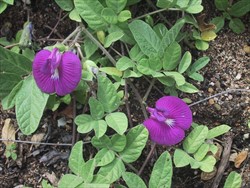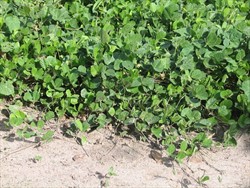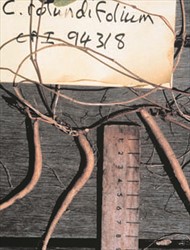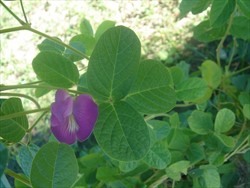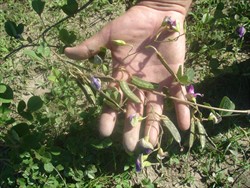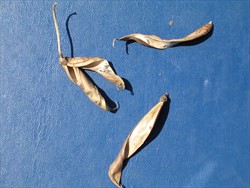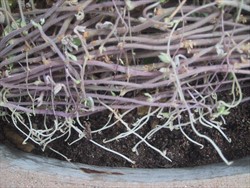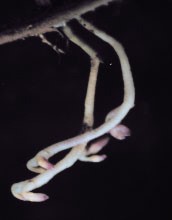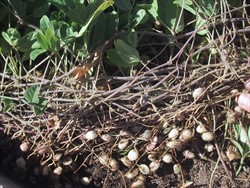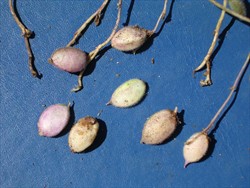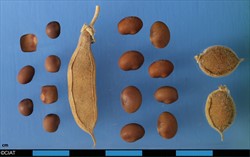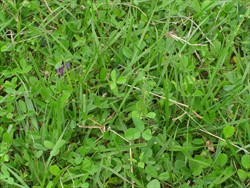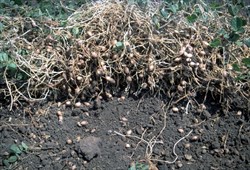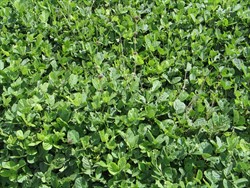Centrosema rotundifolium
Tropical Forages
Centrosema rotundifolium Mart. ex Benth.
GRIN: none recorded
ILDIS: Bradburya rotundifolia (Benth.) Kuntze; Centrosema heptaphyllum Moric.
Family: Fabaceae (alt. Leguminosae) subfamily: Faboideae tribe: Phaseoleae subtribe: Clitoriinae.
Perennial, creeping herb with strong, deep, storage tap roots developing at the nodes of prostrate stems; leaves trifoliolate (seldom pentafoliolate), leaflets broad-elliptical to obovate, 4‒35 mm wide, 6‒45 mm long. Aerial inflorescences with 2‒6 violet flowers, aerial pods falcate, 25‒50 mm long and 4‒7 mm wide with 3‒8 seeds, c. 5 mm long, 3 mm wide.
The species is amphicarpic: in addition to aerial peduncles and inflorescences, belowground peduncles penetrate from nodes of creeping stems into the soil, branch out and produce very small flowers from which 1- (sometimes 2-) seeded pods develop. In comparison with aerial seeds, below-ground seeds are c. 40% larger and heavier. Approx. 15,000 aerial and about 10,000 belowground seeds per kg.
None reported
Native:
South America: Brazil (Alagoas, Bahia, Ceará, Maranhão, Mato Grosso, Minas Gerais, Piauí, Rio de Janeiro, Rio Grande do Norte, São Paulo); Paraguay
Soil requirements
Very sandy, well drained; medium to low fertility, acid to very acid.
Moisture
800‒1,200 mm/yr, 5‒8 dry months. Defoliates in dry season but regrows in rainy season.
Temperature
Warm season growth only, frost tolerance unknown.
Light
Shade tolerance unknown; probably low.
Reproductive development
Flowering and pod setting triggered by drought stress. Species is amphicarpic. Below-ground reproduction cleistogamous, mostly one-seeded pods; aerial reproduction chasmogamous with 3‒8-seeded pods.
Defoliation
Tolerates heavy grazing.
Fire
Regrows after fire from underground xylopodium meristems and soil seed bank.
Guidelines for establishment and management of sown forages.
Establishment
More hardseededness in aerial seed than in below-ground seed; scarification recommended.
Fertilizer
Phosphorus for establishment recommended.
Compatibility (with other species)
Once established, very good.
Companion species
Grasses: Urochloa humidicola and other creeping, stoloniferous grasses.
Pests and diseases
Rhizoctonia foliar blight (occasionally).
Ability to spread
Spread by both stolons and seed.
Weed potential
No information available; probably nil.
Nutritive value
Medium to high. In 8-week old herbage (east Venezuela): CP 22‒24%, P 0.39‒0.45%, Ca 0.52‒0.64%.
Palatability/acceptability
Consumed by cattle and horses.
Toxicity
None recorded.
Dry matter
Low, e.g. in east Venezuela: dry season, 75‒184 kg/ha in 5 months; rainy season: 2,140‒2,420 kg/ha in 4 months.
Animal production
No information available.
2n = 22. Above-ground reproduction appears to be partly allogamous.
In comparison with aerial seed production, below-ground seed production is more than 3 times higher; harvest by sieving of topsoil (first 15 cm); yields of up to 1.5 t/ha are possible.
No information available.
- Excellent adaptation to sand soils.
- Persistence under heavy grazing.
- Amphicarpy enables a continuous replenishment of soil seed bank by below-ground seed production.
- Low dry matter production.
- Harvest of below-ground seed constrains commercial seed production.
Rodríguez, I., Schultze-Kraft, R. and González, S. (2001) Evaluation of Centrosema rotundifolium for sand-soil savannas in Eastern Venezuela. Proceedings of the XIX International Grassland Congress, São Pedro, SP, Brazil, 11–21 February 2001. p. 565–566.
Schultze-Kraft, R. and Clements, R.J. (eds). (1990) Centrosema: Biology, agronomy, and utilization. CIAT Publication No. 92. Centro Internacional de Agricultura Tropical (CIAT), Cali, Colombia. hdl.handle.net/10568/54383.
Schultze-Kraft, R., Keller-Grein, G., Cárdenas, E. and Díaz Bolívar, F. (1994) Potencial de Centrosema rotundifolium como leguminosa forrajera. Pasturas Tropicales 16(3):2–8. bit.ly/2WSYnZU
None released to date.
